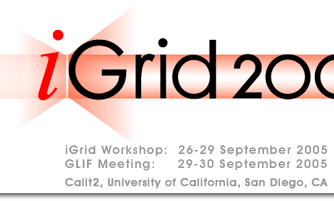Real-Time Applications
Data Services
Data Reservoir [JA, NL, USA]
DataWave [USA, CA, NL]
Exploring Data Using Teraflows [USA, CA, CE, JA, NL]
From Federal Express to Lambdas [USA, AU, CH, GE, JA, KO]
LightForce [USA, CA, NL]
Real-Time Brain Data Acquisition [USA, JA, KO, TW, NL]
Transfer of Cosmic Ray Data from Tibet [CH, IT]
e-Science
ESLEA [UK, USA]
Human Arterial Tree [USA]
Opening Fiber Highway Mexico / USA [MX, USA]
PRIME [USA, AU, CH, JA, TW]
Lambda Services
Coordination of Grid / Lambda Service [JA]
Dynamic Provisioning [USA, JA, NL, SW, UK]
First OVC / Terabit LAN [JA, USA]
Global Lambdas for Physics [USA, CE, BR, KO, UK]
International 10Gb Security [CA, USA, NL]
IPv4 Link-Local IP Addressing [NL]
SPIN and ISON [USA]
Token-Based Network Element [NL]
VM Turntable [USA, NL]
Worlds First X GRID UCLP Switching [CA, KO, SP, TW]
Scientific Instrument Services
20,000 Terabits Beneath the Sea [USA]
Real-Time Observational Data Streaming [TW, CA, JA, UK, USA]
Virtual Laboratory on Demand [PL]
Supercomputing Services
AMROEBA-EA [USA, NL]
Interactive Control [USA]
Large-Scale Sim / Viz with GridLab [PL, CZ, GE, HU, IT, NL, UK, USA]
Video Streaming Services
Collaborative Analysis [USA, GE]
Global N-Way Interactive Conferencing [USA, AU, JA, NL]
HD Multipoint Conference [CZ, USA]
International Real-Time 4K Digital Video [USA, JA]
Large-Scale Multimedia Delivery [PL]
Visualization Services
Cabinet of Dreams [USA, CH]
Dead Cat [NL]
GLVF: Unreliable Stream [NL, USA]
GLVF: NCSA Streaming Stereo [USA]
GLVF: Personal Varrier [USA]
GLVF: SAGE [USA, KO, NL]
GLVF: Solutions Server [CA]
Great Wall Cultural Heritage [CH, USA]
Grid-Based Pipeline [USA]
GridON [SP, CA]
Interactive 3D HD Video [KO, CA, SP, TW]
Interactive Visualization across LONI [USA, CZ, GE, NL]
Real-Time True-3D Viz [USA]
Rutopia2 [USA, RU, SW]
Scientific Collaboration with Earth Science [USA]
UCLP Virtual Design Studio [CA, KO, SP, TW]
Virtual Unism [USA, RU, SW]
Credits
Cactus is an open-source problem-solving environment designed for scientists and engineers. Its modular structure easily enables parallel computation across different architectures and collaborative code development among different groups. Cactus originated in the academic research community, where it was developed and used over many years by a large international collaboration of physicists and computational scientists. See www.cactuscode.org.
LambdaVision is an ultra-high-resolution visualization and networking instrument designed to support collaboration among co-located and remote experts requiring interactive ultra-high-resolution imagery. LambdaVision investigates means to advance both science and public safety as validated by users in various disciplines of Earth science research, and training exercises in disaster response and crisis management. LambdaVision is funded by the USA National Science Foundation award CNS-0420477 to the Electronic Visualization Laboratory at the University of Illinois at Chicago. See www.evl.uic.edu/cavern/lambdavision.
OptIPuter, so named for its use of Optical networking, Internet Protocol, computer storage, processing and visualization technologies, is a 21st-century cyberinfrastructure that will tightly couple computational resources over parallel optical networks using the IP communication mechanism. The goal of this new architecture is to enable scientists who are generating terabytes and petabytes of data to interactively visualize, analyze, and correlate their data from multiple storage sites connected to optical networks. The OptIPuter is funded by the USA National Science Foundation, cooperative agreement SCI-0225642, to Calit2 at UCSD. See www.optiputer.net.
User Controlled LightPaths (UCLP) software allows end-users - either people or sophisticated applications - to treat network resources as software objects and provision and reconfigure lightpaths within a single domain or across multiple, independently managed, domains. Users can also join or divide lightpaths and hand off control and management of these larger or smaller private sub-networks to other users. The first phase of software development was co-funded by Cisco Canada and CANARIE under CANARIE’s Directed Research program. See www.canarie.ca/canet4/uclp.
Scalable Adaptive Graphics Environment (SAGE) is a graphics streaming architecture for supporting collaborative scientific visualization environments with potentially hundreds of megapixels of contiguous display resolution. The network-centered architecture of SAGE allows collaborators to simultaneously run various applications (such as 3D rendering, remote desktop, video streams and 2D maps) on local or remote clusters, and share them by streaming the pixels of each application over ultra-high-speed networks to large tiled displays. SAGE is a research project of the Electronic Visualization Laboratory at the University of Illinois at Chicago, supported by the OptIPuter project, NSF award SCI-0225642 to UCSD. See www.evl.uic.edu/cavern/sage.
Varrier is a panel-based, head-tracked, barrier-strip auto-stereographic display, where the viewer does not wear stereo glasses. The hardware and software are designed to augment the work environment, enabling collaborators to share 3D immersive content alongside 2D content, such as PowerPoint and/or video conferencing. Personal Varrier is a high-resolution one-screen desktop model. Varrier is funded by the USA National Science Foundation award CNS-0115809 to the Electronic Visualization Laboratory at the University of Illinois at Chicago. See www.evl.uic.edu/core.php?mod=4&type=1&indi=275.
Participating countries / locations:
Australia [AU]; Brazil [BR]; Canada [CA]; CERN [CE]; China [CH]; Czech Republic [CZ]; Germany [GE]; Hungary [HU]; Italy [IT]; Japan [JA]; Korea [KO]; Mexico [MX]; Netherlands [NL]; Poland [PL]; Russia [RU]; Spain [SP]; Sweden [SW]; Taiwan [TW]; United Kingdom [UK]; United States of America [USA]. Of course, during the week of iGrid, USA is an active participant in all these demonstrations!


